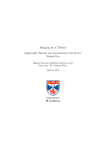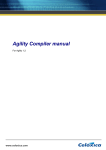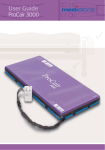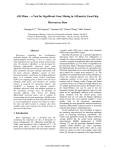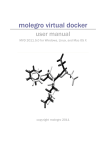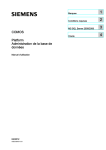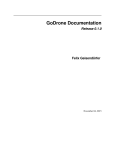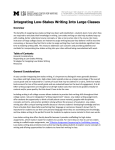Download Lighthouse Final Document
Transcript
May15-17
Advisor: Dr. Mitra
Lighthouse Final
Document
Client: Workiva
Version 1.1
Caleb Brose, Chris Fogerty, Nick Miller, Rob Sheehy, Zach Taylor
April 28, 2015
CONTENTS
Contents ........................................................................................................................................................ 1
1.
Introduction .......................................................................................................................................... 3
Project Definition ...................................................................................................................................... 3
Project Goals ............................................................................................................................................. 3
Definitions of Common Terms and Abbreviations.................................................................................... 3
2.
Deliverables........................................................................................................................................... 4
Lighthouse ................................................................................................................................................. 4
Harbor ....................................................................................................................................................... 4
Beacon ...................................................................................................................................................... 4
Documentation ......................................................................................................................................... 4
3.
System Level Design .............................................................................................................................. 5
System Requirements ............................................................................................................................... 5
Use Cases .............................................................................................................................................. 5
Functional Requirements ...................................................................................................................... 5
Non-Functional Requirements .............................................................................................................. 7
Functional Decomposition ........................................................................................................................ 8
High Level Decomposition .................................................................................................................... 8
Harbor ................................................................................................................................................... 9
Lighthouse ........................................................................................................................................... 10
Beacons ............................................................................................................................................... 10
4.
Detailed Description ........................................................................................................................... 11
Interface Specifications ........................................................................................................................... 11
Lighthouse API .................................................................................................................................... 11
Streaming ................................................................................................................................................ 11
Lighthouse and Beacon ....................................................................................................................... 11
Harbor ................................................................................................................................................. 13
Deployments and Applications ............................................................................................................... 13
Using Applications............................................................................................................................... 14
Design and Implementation................................................................................................................ 14
Technical Issues....................................................................................................................................... 16
Why Do Beacons Exist? ....................................................................................................................... 16
Authentication .................................................................................................................................... 16
Streaming ............................................................................................................................................ 16
5.
Testing ................................................................................................................................................. 17
6.
Conclusion ........................................................................................................................................... 18
7.
Appendix I: User Manual..................................................................................................................... 19
Local Development ................................................................................................................................. 19
Software Requirements ...................................................................................................................... 19
Pulling the Source ............................................................................................................................... 19
Installing Dependencies ...................................................................................................................... 19
Building ............................................................................................................................................... 19
Running ............................................................................................................................................... 19
Testing ................................................................................................................................................. 20
Playing Around .................................................................................................................................... 20
Production Environment ......................................................................................................................... 21
Preferred Operating System ............................................................................................................... 21
Setup Beacon ...................................................................................................................................... 21
Setup Lighthouse................................................................................................................................. 22
8.
Appendix II – Previous Versions .......................................................................................................... 23
Addition of Beacons ................................................................................................................................ 23
Database Paradigms ............................................................................................................................... 24
Beacon Implementation ......................................................................................................................... 25
Application Management ....................................................................................................................... 25
9.
Appendix III: Other Considerations ..................................................................................................... 26
Single Page Application Architecture ...................................................................................................... 26
AngularJS and Go .................................................................................................................................... 26
Requirements Gathering......................................................................................................................... 26
Future Work ............................................................................................................................................ 27
10.
Appendix IV Table of Tables ............................................................................................................ 28
11.
Appendix V Table of Images............................................................................................................ 28
Final Document v1
CprE 492
May15-17
1. INTRODUCTION
Project Definition
Within the past year, Docker has emerged as an execution and deployment environment for distributed
applications. It supports standardized application installation and execution via “containers” built from a
common template that can run on a variety of host platforms. In the past, the efforts to standardize
distributed and scalable applications were focused on the virtual machine, which was replicated across
the desired host platforms. Docker removes the overhead of hosting and running the virtual machine,
and instead utilizes the native system resources, while maintaining the desired isolation one would like
to see between multiple applications running on one system. Docker has achieved near native
performance on application startup and shutdown, meaning new applications can be deployed and
scaled as quickly as possible.
Project Goals
Our goal with Lighthouse is to provide a Docker host management system, capable of interfacing with a
variety of cloud providers including, but not limited to, Google Compute Engine, and Amazon Web
Services. Lighthouse will allow users to authenticate with their target Docker host platform, monitor the
state of their application instances, and deploy new containers from one centralized interface,
significantly reducing the time it requires to deploy and monitor applications across multiple cloud
providers. By the project completion, our goal is to have built a system that is efficient, modular, and
secure.
Definitions of Common Terms and Abbreviations
Term
Definition
Docker
An open source platform used for creating, packaging, and shipping,
and running applications.
Image
A read only file system used by Docker which contains applications and
other files.
Container
A “running” image which is writeable. Containers are primarily used to
run the applications that are being developed.
Registry
An image storage service.
GCE
Google Compute Engine
A virtual machine (VM) hosting service by Google which may host
Docker instances.
AWS
Amazon Web Service
A virtual machine hosting service by Amazon which may host Docker
instances.
JSON
JavaScript Object Notation
A data exchange format which is the primary mode of communication
between the frontend and backend applications.
Beacon
A portion of the Lighthouse Project ecosystem. It lives in the cloud and
provides a single access point for Docker instances in the cloud.
3
Lighthouse
The centralized backend of the Lighthouse Project ecosystem. It
provides an API to access all the Docker systems owned by an
organization.
Harbor
The front-end web application built specifically for use with the
Lighthouse Project. It provides a responsive interface to Docker.
Table 1 Common terms and their definitions
2. DELIVERABLES
The Lighthouse Project consists of the following modules.
Lighthouse
The Lighthouse system is capable of interfacing with an existing instance of Docker. It communicates
with Docker instances via Docker’s REST API, and it is capable of:
Routing all valid Docker API calls through itself to the appropriate Docker instance.
Authenticating users, using per-instance permissions, and blocking unauthorized requests.
Extending Docker’s functionality by intercepting requests to Docker and calling internal
functions, such as logging and history.
Perform batch operations over a collection of Docker instances.
Harbor
Harbor is a web application capable of utilizing Lighthouse to manage Docker instances. It uses
JavaScript, AngularJS, and Oboe to:
Perform basic container management actions such as Create, Stop, Remove, Update, and Pause
View past containers run in the Docker instance. That is, view a history of each application
running on the instance.
Log in and out of the backend application to authenticate frontend users.
Stream the progress of batch operations to the user.
Beacon
The beacon module resides within the cloud provider’s network. This gives it unique access to the
provider’s network-internal APIs for discovering other servers being rented by the user. The beacon
module can:
Detect what provider network it is running on, in order to select the correct API.
Detect Docker instances owned by the user and running within the same network.
Redirect requests from the Lighthouse central back-end to the relevant Docker instance.
The beacon module also includes its own API, so support for new cloud providers can be added with
ease.
Documentation
The Lighthouse API is well documented in order to accommodate users that wish to automate actions,
create their own frontend applications, or extend Harbor with new functionality. This documentation
can be found on GitHub, under the Lighthouse organization.
4
3. SYSTEM LEVEL DESIGN
System Requirements
Use Cases
For a successful implementation of our minimal viable product, we’ve identified two major actors in the
Lighthouse system: release manager, and IT admin.
Release Manager Functions
1. Log in / Authenticate
2. View currently deployed containers
3. Deploy and start a new container
4. Rollback a container deploy to a previous version
IT Administrator Functions
1. Log in / Authenticate
2. Initialize provider with authentication credentials
3. Create and delete system users
4. View provider statistics and analytics
Functional Requirements
Docker addresses
o Description
The IP address that are hosting Docker daemon publicly on port 2375.
o Users
Administrators
o Actions
add
remove
edit
Docker Images
o Description
Each Docker daemon has a set of images referenced by name or UID.
o Users
Developers/Administrators
o Actions
add
remove
edit
Docker Containers
o Description
Each Docker daemon has a set of running containers referenced by name or
UID.
Containers are spawned from images pre-existing inside a Docker daemon.
o Users
5
Developers/Administrators
o Actions
start
Arguments
o exposed port
o command
o environment variables
stop
Docker Analysis
o Description
Should be able to view running containers in real time.
o Users
Developers/Administrators
o Actions
view
logs
CPU usage
memory consumption
Authentication
o Description
Given an email and password all users can be denied or granted access to the
webapp.
o Users
Everyone
o Actions
login
Arguments
o Email
o Password
logout
Authentication Accounts
o Description
Admins should be able to control user accounts.
o Users
Administrators
o Actions
add
remove
edit
6
Non-Functional Requirements
Security System (should be secure and not allow unauthorized control)
● Protect against
○ XSS attacks
○ session hijacking
○ unauthenticated requests
○ exposure of sensitive container/server data
● Only use HTTPS to mitigate various communication security exploits.
Code Quality (should be easy to maintain and understand)
● Git
○ Commit comments should be clear and concise, standard commit conventions
● Style Guides
○ GO
■ style guide
■ effective tips
○ JavaScript
■ style guide
● Code reviews must include at least 2 other team members to be verified for master merge.
7
Functional Decomposition
High Level Decomposition
Figure 1 System Block Diagram
The overall architecture of Lighthouse is built upon the common client-server pattern. Users interact
with the system via a “single page” web application that’s loaded once into their browser, with
subsequent system requests made via a REST API over HTTPS, utilizing JSON as the data interchange
format.
Requests received from the web interface are routed through authentication and API control. Our API is
implemented as a superset of the standard Docker Remote API, allowing users to send specific Docker
requests to their target platform, as well as add new platforms, users, and other infrastructure
configuration.
Host providers manage the actual startup and application runtime, but are controlled via the Lighthouse
main controller. Provider interfaces are installed on each provider as part of the Lighthouse application
and define a common interface for communication between the host network and Lighthouse.
Docker images are hosted on the Docker registry provided by the organization using Lighthouse. Host
providers are instructed to pull new images from the registry on application deployment.
8
Harbor
Figure 2 Harbor block diagram
Harbor’s goal is to present the user with information and provide the user with a simple UI to manage
their array of Docker installations. Using the API exposed by Lighthouse, Harbor renders the response
from Lighthouse into HTML and displays it to the user. Harbor must know how to handle any errors in
communicating with the Lighthouse server, manage user sessions (for logging in and out), and generate
API requests to Lighthouse.
Figure 3 An example of Harbor's UI
9
Lighthouse
Figure 4 Lighthouse block diagram
It is Lighthouse’s job to authenticate users, cache Docker hosts from the provider interface, and provide
features on top of what Docker already provides, such as rolling back deployments. Lighthouse exposes
a REST API (described below) that anyone can build off. While we use it as a way to communicate with
the front-end, the API allows for users to build easily build automation into their systems. The back-end
communicates with provider interface(s) in order to discover any cloud instance that is owned by the
user and running Docker. It must also elegantly handle errors by returning a sane response to the client,
and log any errors or events that pop up.
Beacons
Figure 5 Beacon block diagram
10
The beacon is installed within each cloud segment the user wants to access. It allows us to use a single
API on the back-end to locate relevant cloud instances across all providers. By being in the relevant
cloud, the beacon is granted access to privileged APIs, allowing it to discover other instances owned by
the same account.
4. DETAILED DESCRIPTION
Interface Specifications
Lighthouse API
The Lighthouse module provides a REST API as an interface between the UI and the back end logic. This
API exposes endpoints that allow clients to control Docker, authenticate users, modify users and
permissions, interact with beacons, and manage applications. The full API documentation is a bit large to
fit here, but can be found on GitHub, under the Lighthouse organization.
Streaming
Lighthouse’s core functionality revolves around the batch processing of large deployments. As the
number of deployments scales up, so does the latency of the processing. The combination of multithreaded processing and incremental status updates becomes critical functionality as the instance count
in a deployment reaches into the hundreds.
Figure 6 Streaming UI in Harbor
Lighthouse and Beacon
To successfully build out a stream oriented API, our design required coordination between each major
component. Lighthouse, acting as the core mediator between each component in a request, takes two
approaches to handling response streams. The first is focused on Docker requests.
11
Incoming Docker requests are routed to the appropriate Beacon instance, which, in turn, forwards the
request onto the targeted Docker instance. The open TCP connections are read from and written to in
pre-defined byte segments, instead of the entire response. The diagram below illustrates the connection
relationship and read/write characteristics.
Figure 7 Streaming concept diagram
The implementation for the read/write portion of a component in the stack above is relatively
straightforward. A pre-defined byte segment is read from the response buffer and relayed to the next
client as a byte segment of the same size. See Appendix IV.
One important aspect to consider is the nature of the listening client. A nice property of this
implementation is that it will work for any client expecting either a streaming response or blocking
response. A blocking client will not process its response until all incoming bytes have been stored and
the connection closed. In this case, the underlying transport layer (i.e. TCP) seamlessly manages the
incoming buffer, passing it to the application layer (i.e. client) once the response is complete. Therefore,
12
all Docker responses from instances are treated as if they were streams, since clients gracefully handle
either case.
Lighthouse’s second approach is focused on the application API. Here, incremental status objects as
described the Applications section are written to the response stream and flushed immediately. The end
result here is the same as in Docker responses.
Harbor
Harbor’s internal services handle asynchronous requests and responses by utilizing the underlying
browser API. Asynchronous HTTP requests (commonly referred to as Ajax) have been prevalent for quite
some time, and many Javascript libraries take advantage of this, providing a clean interface to develop
against.
oboe({
method: 'POST',
url: _url(request),
body: request.body || {}
})
.start(function () {
// process stream start
})
.node('{Status}', function (status) {
// process status object
})
.fail(function (error) {
// process failure
});
Figure 8 Stream Processing code example
In Harbor’s case, it utilizes oboe.js, to process and dispatch internal events as the incoming streaming is
processed. Oboe’s API model revolves around the knowledge of the stream structure (as a JSON data
segment) to trigger state specific processing. An example of this processing is given above, for the
application deploy stream.
Effectively, oboe watches the incoming JSON stream for specific attributes (in this case, a specific key,
“Status”) and calls the registered callback function for that event. Harbor can then perform its own
asynchronous data processing (i.e. update the UI) to show the incremental deploy status.
Docker image pull streams are handled in a similar manner, but instead, a progress bar is updated during
the callback. Ultimately, the consideration of streaming APIs and incremental status updates sets up an
environment for more responsive UIs and a smoother user experience. Streaming functionality can be
further exploited to show real-time network statistics and instance resource load.
Deployments and Applications
Application management is one of Lighthouse’s key features in terms of extending Docker’s existing
functionality. When a developer thinks of their application, they are probably imagining one object
running in one location. This abstraction works perfectly well for writing applications, but a release
manager does not have this luxury. When a new version of an application is created, the release
manager has to think of the application as many objects running across many machines, these machines
13
are in fact the instances of Docker which run the application. The actual process of updating an
application is both time consuming, tedious, and error prone as the release manager must interface with
each of the potentially hundreds of instances to manually perform the update one at a time. With our
application management features, we provide a layer on top of this which allows the release manager to
think of the application like a developer, as a single entity.
Using Applications
Creating an Application
There’s a first time for everything and the same is true for applications. In order to get an application up
and running, all the user has to do is provide a set of Docker instance which will actually be running the
application and the set of instructions telling the application what to do. From here, Lighthouse handles
all the busy work of telling each instance to start running the new application.
Updating an Application
Of course, no application ever has a single version and some applications will take off faster than others.
To accommodate, we let the user update their application in a very painless manner. To update the
code running in the application, the user only has to provide a new set of instructions just like they did
when they created the application. Applications can be scaled up or down in an equally painless way,
the user only has to tell Lighthouse any instances they would like to add or remove from an application
and Lighthouse will handle the rest.
Reverting an Application
Unfortunately, mistakes are a very real event and when a bug in the code is bringing an
application down it needs to be corrected as quickly as possible. Lighthouse can be
instructed to rollback applications any number of stages, all the way back to the original
version. This makes the rollback process painless as the user can go back to a stable
version without even having to enter a command.
Design and Implementation
Database Design
Applications are stored in two tables, one storing the applications themselves and another
which contains the different versions of the application which we call deployments.
Figure 9 Deployment and Application database design
14
This design allows us to quickly get general information about an application by simply querying the
Applications table and lets us perform new deployments by appending a new row to the Deployments
table with the new command.
Batch Processing
The key feature of application management is sending requests to many instances all at once, we do this
through batch processing. For Lighthouse, a batch process needs only a list of instances to communicate
with and the message it needs to tell them. From here the batch process will send requests to each
instance in parallel which will make the entire process much faster. To keep the user informed, the
process will create an update stream which is used to report successes, failures, and any administrative
data the user would need to know. If any errors were to occur during the process, a rollback procedure
is performed to ensure that all instances are always in the same state as one another. There are
certainly cases where a single request from the user will need to send multiple requests to each instance
(an application update for example). When multiple requests are needed, each request waits for the
one before it to complete before starting.
Concurrent request processing is easy to implement by using Go’s goroutine and channel functionalities.
Channels operate as thread-safe queues and goroutines are easy to make threads which each carry out
one request to a single instance. The goroutines carry out their function and then report their status to
the master thread via channels. The master thread simply spawns the thread and waits for them to end.
Streaming Responses
For all of Lighthouse’s application management functions which require batch operations, the response
to the client is in the form of a stream which is constantly updated. The reason for this is to provide the
client with real-time updates of what is happening server-side rather than having to wait for all
processing to complete (which could take several minutes) before reporting anything. These updates
have the form:
{
Status
Method
Endpoint
Message
Code
Instance
Item
Total
("OK", "Warning", "Error", "Starting", "Complete", "Finalized")
("GET", "POST", "PUT", "DELETE")
("containers/create", ...)
("", "<Warning Reason>, "<Endpoint>", ...)
("myInstance.com:5000/v1.12")
(0 to Total)
}
Figure 10 Streaming response, general form
The issue is that when Lighthouse sends out requests in a batch operation, there isn’t really any way of
knowing in what order they will complete (due to things like request latency or processing power of the
destination instance). Lighthouse does, however, know when it creates new batch request and when
that request has completed. For this reason, the update stream is formatted as a series of blocks which
begin with an update with status “Starting” and end with an update with status “Complete”. The blocks
in turn wrap a series of updates relaying responses from individual instances which will tell the client
whether the block completed successfully or not. Because many different requests will return a stream,
each requiring a different number of blocks, there must be a way for the client to know that the request
15
is complete. To accommodate, Lighthouse sends a single update with status “Finalized” when the
request is fully completed, regardless of success or failure. The client should only consider the request
complete once this update is received. An example of an entire update stream is shown below.
{"Status":"Starting", "Method":"DELETE", "Endpoint":"containers/my_app",
"Message":"Deleting old container", "Code":0, "Instance":"", "Item":0,
"Total":4}
{"Status":"OK", "Method":"DELETE", "Endpoint":"containers/my_app",
"Message":"", "Code":404, "Instance":"instance0.com", "Item":0, "Total":4}
{"Status":"Warning", "Method":"DELETE", "Endpoint":"containers/my_app",
"Message":"No such container", "Code":404, "Instance":"instance2.com",
"Item":2, "Total":4}
{"Status":"Error", "Method":"DELETE", "Endpoint":"containers/my_app",
"Message":"", "Code":400, "Instance":"instance1.com", "Item":1, "Total":4}
{"Status":"Error", "Method":"DELETE", "Endpoint":"containers/my_app",
"Message":"host unreachable", "Code":500, "Instance":"instance3.com",
"Item":3, "Total":4}
{"Status":"Complete", "Method":"DELETE", "Endpoint":"containers/my_app",
"Message":"Deleting old container", "Code":0, "Instance":"", "Item":4,
"Total":4}
{"Status":"Finalized", "Method":"", "Endpoint":"", "Message":"", "Code":0,
"Instance":"", "Item":0, "Total":0}
Figure 11 Update Stream example
Technical Issues
Why Do Beacons Exist?
Beacons came about as a result of our desire to make it as easy as possible to get the Lighthouse
ecosystem up and running. We realized that many organizations may already have Docker swarms set
up, and it would be tedious to add hundreds of Docker instances to Lighthouse manually. At the same
time, we were searching for a solution to make it easy for Lighthouse to communicate with hundreds of
Docker instances. This would also be tedious to set up if each Docker instance required its own static
(and public-facing) IP address. The solution we designed was the Beacon module.
Authentication
This issue arose in the middle of March 2015. Everything was coming together, and we were about to
get user management features online, when two team members caused the Lighthouse authentication
state and the Harbor authentication state to get out-of-sync. This caused issues where Harbor indicated
to the user that they were logged, but Lighthouse had no recollection of this session. The solution was to
generate a notification on the server to automatically inform the client of its authentication state.
Streaming
The idea for streaming status happened over a code jam, when we realized Harbor had no way of
indicating how far an operation (especially a batch operation) had completed before failing. It was also
16
not possible to view status, progress, or logs without manually refreshing the page. This contradicted
our goal of having a quick response time for user interactions.
This issue was especially challenging due to the nature of HTTP responses. While the protocol supports
streaming, the response (and stream) needed to work its way along three hops to the final Docker
instance, requiring a lot of coordination from Lighthouse and Beacon.
5. TESTING
The Lighthouse testing and code quality process consists of multiple steps that ensure a
high quality product is being created, while also allowing rapid development and continuous
release. We use a test-driven development process to continuously deliver tested code
throughout our development of Lighthouse. This gives the project auditability and a solid set
of standards.
Since we use Git and GitHub, our development process revolves around pull requests.
These are requests to merge new code into the master branch of our repositories. Once a
developer has completed their task and is ready for it to be reviewed, they create a pull
request. An example is here: https://github.com/lighthouse/lighthouse/pull/50. On this pull
request, developers can view the file additions and deletions, discuss and review the code,
and ensure that certain checks have been met. This methodology allows developers to
review other’s code and approve. This leads to a very high quality product.
On each pull request a certain set of checks must be completed. Our process requires the
following for new code to be merged: the full test suite must pass, code coverage must not
drop below a certain threshold, and one of two other developers must sign off on it. We use
two services to assist with this process. We use Travis CI (https://travis-ci.org) to run the full
test suite on every commit and report to GitHub whether they passed or failed. Coveralls
(https://coveralls.io) helps us track code coverage for the test suite. If the coverage
decreases by a certain threshold (around 6%) a failure is indicated on the pull request. This
ensures that we meet a testing standard and that new code includes tests. The following
screenshot shows what that checklist looks like.
17
Figure 12 Automated Testing checklist
6. CONCLUSION
With the advent of Docker, there has been a torrent of new technical challenges surrounding the
technology. Now that Docker has landed and has become an important and accepted industry standard,
the foundation has been created. Some of the new challenges will be around building on top of this
technology, particularly management, security, and development of best practices.
Lighthouse’s main purpose is to tackle the management of the Docker platform. Our main goal is to
make management of this platform simple, efficient, and secure. By communicating frequently with
potential stakeholders, making the project open, and using standard and modern technologies, we will
be able to accomplish the goals outlined in this document, which will allow Lighthouse to be a successful
and useful tool for Docker management.
18
Final Document v1
CprE 492
May15-17
7. APPENDIX I: USER MANUAL
Local Development
Software Requirements
The following items are required for building and running in a development environment. Make sure
this software is installed on your hardware before you do anything else!
Docker (note) install boot2docker for OSX and windows operating systems
Node
Go
Git
Pulling the Source
Once you have the software installed, it’s time to clone the source code.
Harbor
git clone [email protected]:lighthouse/harbor.git
Lighthouse
go get -t github.com/lighthouse/lighthouse
Beacon
go get -t github.com/lighthouse/beacon
Installing Dependencies
As soon as you’ve pulled everything it’s time to install the project dependencies.
Harbor
o npm install -g bower
o bower install
o npm install -g gulp
o npm install -g karma-cli
o npm install
Lighthouse
o docker pull postgres:latest
Building
Now that dependencies are installed, it’s time to build each project.
Harbor
o gulp build --gopath
Lighthouse
o go install github.com/lighthouse/lighthouse
Beacon
o go install github.com/lighthouse/beacon
Running
Once we’ve compiled everything, it’s time to get down to the nitty gritty of running everything.
Lighthouse
o cd $GOPATH/src/github.com/lighthouse/lighthouse
o docker run -p 5432:5432 -d postgres:latest
o $GOPATH/bin/lighthouse --databases-reload
19
Beacon
o $GOPATH/bin/beacon -token foobar -h 0.0.0.0:5001 -driver local
Testing
Now for everyone’s favorite part, testing.
Harbor
o npm test
Lighthouse
o go test github.com/lighthouse/lighthouse/... -cover
Beacon
o go test github.com/lighthouse/beacon/... –cover
Playing Around
Now that everything is happily running, let’s do some magic.
Visit localhost:5000/login
Enter in your credentials
o (Default) Email: [email protected]
o (Default) Password: admin
Figure 13 Logging in
Click “Add Beacon” and administer the following information
o Alias:
Local Beacon
o Address: 127.0.0.1:5001
o Token:
foobar
20
Figure 14 Connecting to a Beacon
Production Environment
Preferred Operating System
For all of these projects we recommend using any Linux distribution that runs Docker as the OS.
Throughout the project we favored CoreOS.
Setup Beacon
Right now Beacon is configured to run on two cloud providers out of the box. Those two cloud providers
include Google Compute Engine and Digital Ocean. Refer to the GitHub project read me for setting up
Google Compute Engine and Digital Ocean for Beacon. Otherwise Beacon offers the option of allowing a
configuration file to define which VMs are available in a network. For information on Beacon
configuration files read this.
Pull Image
o docker pull lighthouse/beacon:latest
Basic Run
o docker run -d -p 5000:5000 lighthouse/beacon:latest -h 0.0.0.0:5000
Using SSL
o docker run -d -p 5000:5000 -v /path/to/cert/dir:/certs lighthouse/beacon:latest -key
/certs/server.key -pem /certs/server.pem -h 0.0.0.0:5000
Force Driver
o docker run -d -p 5000:5000 lighthouse/beacon:latest -driver config -h 0.0.0.0:5000
Use Custom Authentication Token
21
o
Docker run -d -p 5000:5000 lighthouse/beacon:latest -token imasecret -h 0.0.0.0:5000
Setup Lighthouse
Pull Image
o docker pull lighthouse/lighthouse:latest
o docker pull postgres:latest
Start Database
o docker run --name postgres-image -d postgres:latest
Basic Run
o docker run -t -i --rm -p 5000:5000 --link postgres-image:postgres
lighthouse/lighthouse:latest
Load Credentials Into Database From Config File
o docker run -t -i --rm -p 5000:5000 --link postgres-image:postgres
lighthouse/lighthouse:latest -databases-reload
22
8. APPENDIX II – PREVIOUS VERSIONS
During development, the design of Lighthouse was constantly reevaluated as we gained a better and
better grasp of the problem domain. There were very few modifications that would be noticed at a high
level view, the most prominent being the addition of Beacons. Instead most design changes were
hidden inside the lower parts of the technology stack, examples of this being database paradigms,
Beacon implementations, and Application management.
Addition of Beacons
Early in design we intended for there to be only one end-to-end backend system which would have all
the functionality now provided by Lighthouse as well as the abstractions provided by Beacon. This
would be achieved by having the provider drivers intercept outgoing requests which applied to the
systems they managed and applying any additional headers or formatting that was required to access
that system. The figure below illustrates this early vision of Lighthouse. This model was updated to the
current version for two primary reasons. The first was simply that the interception management would
have added a lot of complexity to Lighthouse’s pipeline. The second, and more important, reason was
that this model was not completely feasible as many cloud providers will have firewalls which would
have blocked the requests coming from Lighthouse. By installing Beacons inside the provider itself, we
allow Lighthouse to bypass this firewall in a secure manner.
Figure 15 First version with Beacons
23
Database Paradigms
From verifying users to deploying applications, a substantial amount of Lighthouse’s operations rely on
databases. For this reason, we developed a very extensive databases package which abstracted things
like query generation and result extraction into one concise interface. This helped to both improve
codebase readability and reduce testing overhead. However, because the environment of Lighthouse
was constantly being updated and this package was no exception.
At creation, all tables that Lighthouse used were simple key-value lookups where the key was always
some string and the value was a JSON object. The benefit of this implementation was just its simplicity,
there was only one column to query by, one column that could be updated, etc. This method worked
very well for things like users which would only need to be extracted by their emails. However, when
development reached the implementation of Beacons, we saw our first object that needed to be looked
up by more than one value (Beacon address or instance address) and as a result, we needed a more
sophisticated architecture.
The second iteration of the databases package saw the addition of schemas. Here an object would be
added to the database by extracting each of its fields as a column. This method was incredibly powerful
as we could store and lookup any of our objects by any of its values. The tables below shows how the
actual storage inside the database changed using our table of Docker instances as an example.
Key
Value
“127.0.0.1/v1.12” {
“InstanceAddress” : “127.0.0.1/v1.12”,
“BeaconAddress” : “127.0.0.1:5001”,
“Name” : “myInstance”,
“CanAccessDocker” : true
}
Table 2 Key-Value Storage
InstanceAddress
BeaconAddress
Name
CanAccessDocker
“127.0.0.1/v1.12” “127.0.0.1:5001” “myInstance” true
Table 3 Schema Storage
Obviously this method is clearer and has a much smaller storage overhead. Its implementation is
substantially more complicated, but the benefits far outweigh this complexity and through unit testing
we are confident that the implementation is correct.
The final paradigm shift in databases was due to a desire to add support for new databases. Currently
Lighthouse only supports Postgres databases, but this is far less strict now than at it was at conception.
At some point, the digital rubber must meet the road and real queries and execs must be generated.
Originally this was done inside the databases package itself and the package created strings specific to
the Postgres syntax. If the user’s database did not support this syntax then Lighthouse was simply not
going to work with it. Of course this isn’t a behavior most users would appreciate, we needed a way to
24
be able to generate database specific strings. This led to the creation of what we call Compilers. These
are drivers for a specific database that are capable of generating strings for their particular database.
With this method, the user need only specify the Compiler to use and the databases package will load it
and operate normally. This was a much more modular design than we had originally created.
Beacon Implementation
As already mentioned, Beacons we not originally part of our end-to-end pipeline. Once they were
however, there was some discussion about what their actual duty would be. Because the ancestor of
Beacon, the provider driver had been developed inside Lighthouse, it was partially tied to some of that
functionality. Our decision was how much of that functionality would migrate with Beacons and how
much would remain in Lighthouse. One proposal was to have “heavy” Beacons and make Lighthouse
“light.” What this means is that each Beacon would be capable of most of the functionality that
Lighthouse currently provides and Lighthouse itself would mostly handle routing. This method did help
us abstract some functionality to simplify our implementations, but was not very feasible as it would
have required that each Beacon have access to its own database which was far too much overhead to
have to be replicated across the many cloud providers the user may have. Instead our implementation
uses “light” Beacons which provide routing for a “heavy” Lighthouse, essentially the opposite of this
proposal.
Application Management
The concept of Applications is not implemented by Docker and as a result their design was one of the
most complicated aspects of the project. The initial concept was intercepting Container management
requests that passed through Lighthouse and to group them by name into Applications. With this
method, the frontend system would be largely in charge of performing the batch functionality required
of Applications. At a high level, this works, but when the development process is considered there are
issues, the most obvious of which being that Applications are only loosely connected as Containers that
share a name. Consider developers who use Docker and create many containers for their own local
tests. It is very possible that these developers would be giving their containers names and we would
very likely see Applications being created that weren’t true Applications because of name collisions.
When we realized this, the Applications infrastructure was modified to the stand-alone architecture that
it is now.
25
9. APPENDIX III: OTHER CONSIDERATIONS
The development process over the course of our project certainly proved to be challenging. Early design
choices forced us into certain conceptual models that played a large role in later work, and learning new
frameworks and languages in the process only added to the complexity of the work involved.
Single Page Application Architecture
As outlined in the Technical Issues section above, the single-page application architecture with Harbor
posed some interesting design challenges with regards to session management. While we were able to
build out a design around the architecture, hindsight suggests a different approach should have been
taken to ensure session management was central to the initial design process, considering the multiuser and collaborative nature of Lighthouse.
With that said, there have been numerous benefits to our decision to use a single-page architecture.
Client-side template rendering is extremely responsive and increases the perception of speed as the
user navigates through the application. Strict client-side data management means that other pages can
be navigated to without transient data such as streaming updates having to persist in the slower
browser cache or on the server. Wrapping the entire front-end into a unified framework also helped to
ease the development process, allowing us to effectively treat Harbor as a separate project in and of
itself, by placing it in a separate version control repository. This means that Lighthouse and Harbor can
have independent release cycles and two development branches can be tested simultaneously with
minimal friction.
AngularJS and Go
Coming into the initial development effort, not everyone on our team had experience with the entire
technology stack we had settled upon. While this is certainly a common trend in professional
development teams (especially with new hires), it’s important to take these factors into consideration
when ramping up the development momentum. The relative immaturity of AngularJS and Go meant
certain issues were met too late in the development process and reverting the choice to use the
framework and/or language was not an option. Fortunately, the online communities surrounding these
technologies are quite large and provided us with a platform and learning and troubleshooting not many
environments have.
Requirements Gathering
One of the major takeaways from our development process was considering the importance of the
initial requirements gathering process. Complexity in software is generally considered a rule, not an
exception, with the end goal being to minimize both domain modeling complexity and accidental
complexity in the feature set.
Initial meetings with our client, Workiva, were beneficial in providing us with a small set of initial
features to begin developing, but, ultimately, the direction of the project was left to our discretion.
While the freedom to develop an open-ended project has its benefits, there is a certain amount of
benefit to restriction as well. Small, isolated software components allow for modular integration into
larger systems and tend to be more stable pieces of software. The work we’ve done on Lighthouse has
only solidified the understanding of a need for a rigid and comprehensive requirements gathering
process.
26
Future Work
As the community surrounding Docker and isolated, container-based deployments grows, so will the use
cases for Lighthouse. Even without considering the future changes to distributed application
development, the feature set of Lighthouse can certainly be increased in the meantime. Two major
features that come to mind are network monitoring for a specific container and resource monitoring for
a Docker instance as whole.
Lighthouse and the related components (Harbor and Beacon) are licensed as open source under the
Apache2 license, allowing developers to contribute and expand on the project in the future.
27
10.
APPENDIX IV TABLE OF TABLES
Table 1 Common terms and their definitions ............................................................................................... 4
Table 2 Key-Value Storage .......................................................................................................................... 24
Table 3 Schema Storage .............................................................................................................................. 24
11.
APPENDIX V TABLE OF IMAGES
Figure 1 System Block Diagram ..................................................................................................................... 8
Figure 2 Harbor block diagram ..................................................................................................................... 9
Figure 3 An example of Harbor's UI .............................................................................................................. 9
Figure 4 Lighthouse block diagram ............................................................................................................. 10
Figure 5 Beacon block diagram ................................................................................................................... 10
Figure 6 Streaming UI in Harbor ................................................................................................................. 11
Figure 7 Streaming concept diagram .......................................................................................................... 12
Figure 8 Stream Processing code example ................................................................................................. 13
Figure 9 Deployment and Applicaiton database design ............................................................................. 14
Figure 10 Streaming response, general form ............................................................................................. 15
Figure 11 Update Stream example ............................................................................................................. 16
Figure 12 Automated Testing checklist ....................................................................................................... 18
Figure 13 Loggin in ...................................................................................................................................... 20
Figure 14 Connecting to a Beacon .............................................................................................................. 21
Figure 15 First version with Beacons .......................................................................................................... 23
28





























